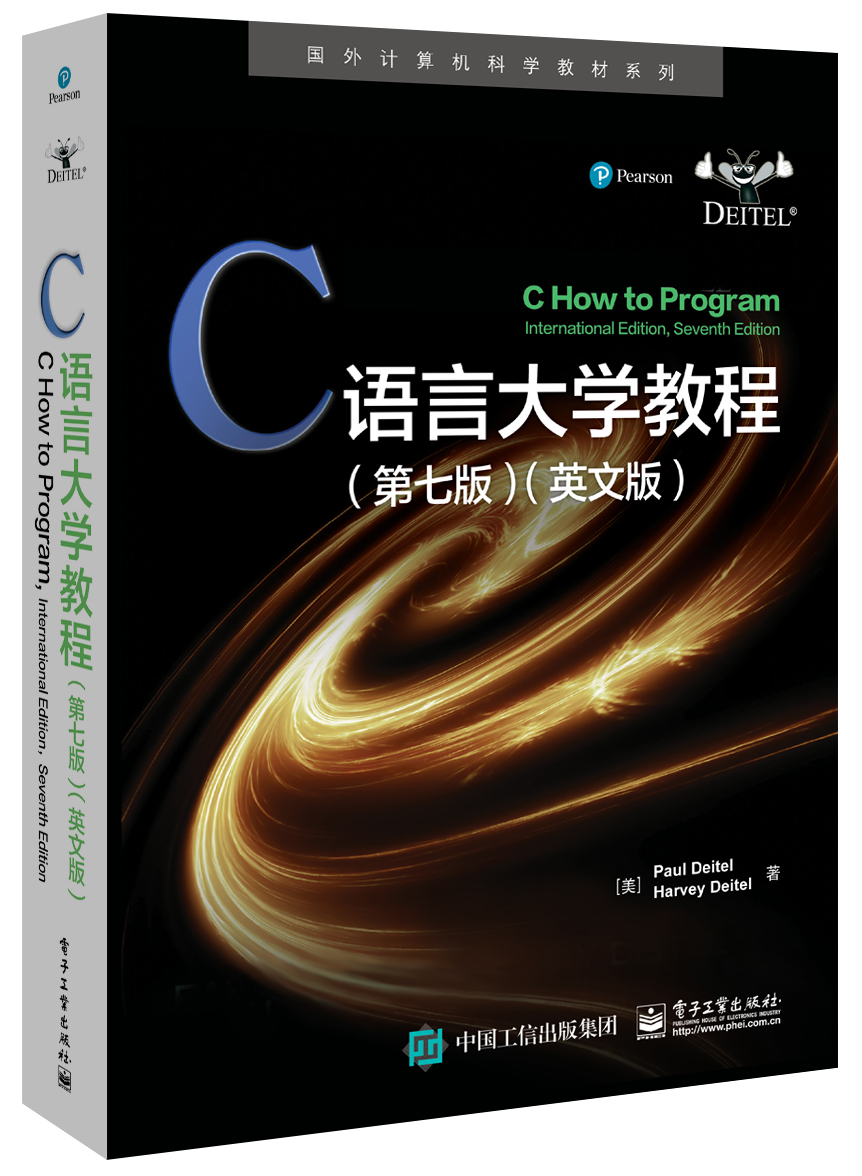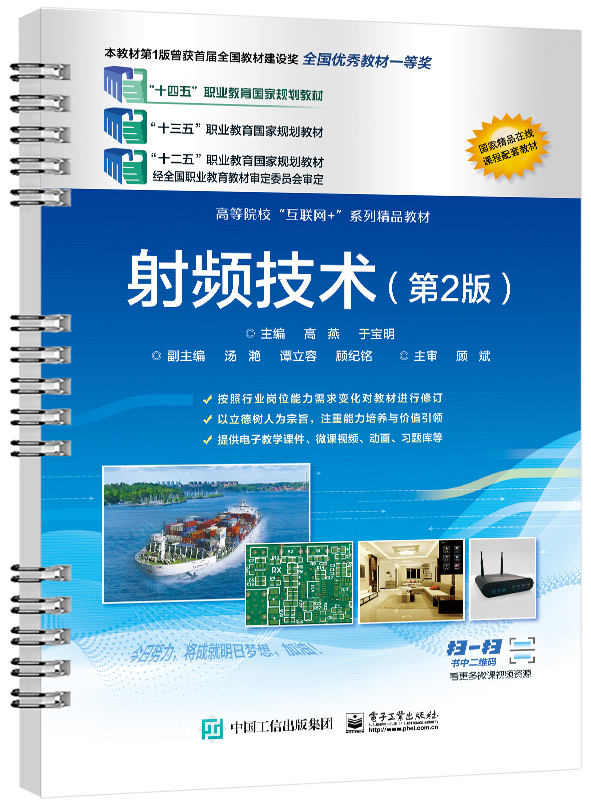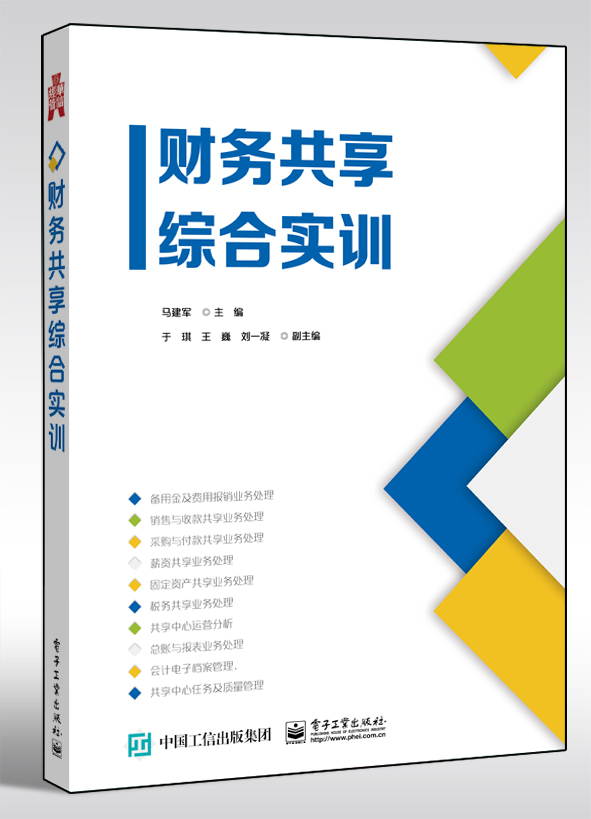C语言大学教程(第七版)(英文版)
丛 书 名:
国外计算机科学教材系列
作 译 者:Paul Deitel(保罗? 戴特尔),Harvey Deitel(哈维? 戴特尔)
出 版 日 期:2018-06-01
书 代 号:G0343370
I S B N:9787121343377
图书简介:
本书是全球畅销的C语言教程之一。全书系统地介绍了4种当今流行的程序设计方法——面向过程、基于对象、面向对象以及泛型编程,内容全面、生动、易懂,作者由浅入深地介绍了结构化编程及软件工程的基本概念,从简单的概念到最终的完整的语言描述,清晰、准确、透彻、详细地讲解了C语言,尤其注重程序设计思想和方法的介绍。相对于上一版,这一版在内容方面新增加了C安全程序设计、"更上一层楼”习题集,更新了C++和面向对象程序设计、基于Allegro的游戏编程、C99标准介绍等内容。
-
配 套 资 源
-
图 书 内 容
内容简介
本书是全球畅销的C语言教程之一。全书系统地介绍了4种当今流行的程序设计方法——面向过程、基于对象、面向对象以及泛型编程,内容全面、生动、易懂,作者由浅入深地介绍了结构化编程及软件工程的基本概念,从简单的概念到最终的完整的语言描述,清晰、准确、透彻、详细地讲解了C语言,尤其注重程序设计思想和方法的介绍。相对于上一版,这一版在内容方面新增加了C安全程序设计、"更上一层楼”习题集,更新了C++和面向对象程序设计、基于Allegro的游戏编程、C99标准介绍等内容。图书详情
ISBN:9787121343377开 本:16开页 数:808字 数:1891.0本书目录
Contents Chapter 1 Introduction to Computers, the Internet and the Web 1 1.1 Introduction 2 1.2 Computers and the Internet in Industry and Research 2 1.3 Hardware and Software 4 1.4 Data Hierarchy 6 1.5 Programming Languages 7 1.6 The C Programming Language 7 1.7 C Standard Library 9 1.8 C++ and Other C-Based Languages 9 1.9 Object Technology 10 1.10 Typical C Program Development Environment 12 1.11 Test-Driving a C Application in Windows, Linux and Mac OS X 14 1.12 Operating Systems 21 1.13 The Internet and World Wide Web 23 1.14 Some Key Software Development Terminology 24 1.15 Keeping Up-to-Date with Information Technologies 25 1.16 Web Resources 26 Chapter 2 Introduction to C Programming 32 2.1 Introduction 32 2.2 A Simple C Program: Printing a Line of Text 32 2.3 Another Simple C Program: Adding Two Integers 36 2.4 Memory Concepts 39 2.5 Arithmetic in C 40 2.6 Decision Making: Equality and Relational Operators 43 2.7 Secure C Programming 46 Chapter 3 Structured Program Development in C 58 3.1 Introduction 58 3.2 Algorithms 59 3.3 Pseudocode 59 3.4 Control Structures 59 3.5 The if Selection Statement 61 3.6 The if…else Selection Statement 62 3.7 The while Repetition Statement 65 3.8 Formulating Algorithms Case Study 1: CounterControlled Repetition 66 3.9 Formulating Algorithms with Top-Down, Stepwise Refinement Case Study 2: Sentinel-Controlled Repetition 67 3.10 Formulating Algorithms with Top-Down, Stepwise Refinement Case Study 3: Nested Control Statements 72 3.11 Assignment Operators 75 3.12 Increment and Decrement Operators 76 3.13 Secure C Programming 78 Chapter 4 C Program Control 95 4.1 Introduction 95 4.2 Repetition Essentials 96 4.3 Counter-Controlled Repetition 96 4.4 for Repetition Statement 98 4.5 for Statement: Notes and Observations 100 4.6 Examples Using the for Statement 100 4.7 switch Multiple-Selection Statement 103 4.8 do…while Repetition Statement 108 4.9 break and continue Statements 109 4.10 Logical Operators 111 4.11 Confusing Equality (==) and Assignment (=) Operators 113 4.12 Structured Programming Summary 114 4.13 Secure C Programming 118 Chapter 5 C Functions 132 5.1 Introduction 133 5.2 Program Modules in C 133 5.3 Math Library Functions 134 5.4 Functions 135 5.5 Function Definitions 135 5.6 Function Prototypes: A Deeper Look 139 5.7 Function Call Stack and Stack Frames 141 5.8 Headers 143 5.9 Passing Arguments By Value and By Reference 144 5.10 Random Number Generation 145 5.11 Example: A Game of Chance 148 5.12 Storage Classes 151 5.13 Scope Rules 152 5.14 Recursion 155 5.15 Example Using Recursion: Fibonacci Series 158 5.16 Recursion vs. Iteration 160 5.17 Secure C Programming 162 Chapter 6 C Arrays 181 6.1 Introduction 181 6.2 Arrays 182 6.3 Defining Arrays 182 6.4 Array Examples 183 6.5 Passing Arrays to Functions 193 6.6 Sorting Arrays 196 6.7 Case Study: Computing Mean, Median and Mode Using Arrays 198 6.8 Searching Arrays 202 6.9 Multidimensional Arrays 206 6.10 Variable-Length Arrays 211 6.11 Secure C Programming 213 Chapter 7 C Pointers 230 7.1 Introduction 231 7.2 Pointer Variable Definitions and Initialization 231 7.3 Pointer Operators 232 7.4 Passing Arguments to Functions by Reference 233 7.5 Using the const Qualifier with Pointers 235 7.6 Bubble Sort Using Pass-by-Reference 241 7.7 sizeof Operator 243 7.8 Pointer Expressions and Pointer Arithmetic 245 7.9 Relationship between Pointers and Arrays 247 7.10 Arrays of Pointers 250 7.11 Case Study: Card Shuffling and Dealing Simulation 251 7.12 Pointers to Functions 254 7.13 Secure C Programming 258 Chapter 8 C Characters and Strings 277 8.1 Introduction 278 8.2 Fundamentals of Strings and Characters 278 8.3 Character-Handling Library 280 8.4 String-Conversion Functions 284 8.5 Standard Input/Output Library Functions 286 8.6 String-Manipulation Functions of the StringHandling Library 289 8.7 Comparison Functions of the String-Handling Library 291 8.8 Search Functions of the String-Handling Library 292 8.9 Memory Functions of the String-Handling Library 297 8.10 Other Functions of the String-Handling Library 300 8.11 Secure C Programming 301 Chapter 9 C Formatted Input/Output 314 9.1 Introduction 314 9.2 Streams 315 9.3 Formatting Output with printf 315 9.4 Printing Integers 315 9.5 Printing Floating-Point Numbers 316 9.6 Printing Strings and Characters 318 9.7 Other Conversion Specifiers 318 9.8 Printing with Field Widths and Precision 319 9.9 Using Flags in the printf Format Control String 321 9.10 Printing Literals and Escape Sequences 323 9.11 Reading Formatted Input with scanf 323 9.12 Secure C Programming 328 Chapter 10 C Structures, Unions, Bit Manipulation and Enumerations 335 10.1 Introduction 336 10.2 Structure Definitions 336 10.3 Initializing Structures 338 10.4 Accessing Structure Members 338 10.5 Using Structures with Functions 340 10.6 typedef 340 10.7 Example: High-Performance Card Shuffling and Dealing Simulation 341 10.8 Unions 343 10.9 Bitwise Operators 344 10.10 Bit Fields 351 10.11 Enumeration Constants 353 10.12 Secure C Programming 355 Chapter 11 C File Processing 365 11.1 Introduction 365 11.2 Files and Streams 366 11.3 Creating a Sequential-Access File 366 11.4 Reading Data from a Sequential-Access File 370 11.5 Random-Access Files 373 11.6 Creating a Random-Access File 374 11.7 Writing Data Randomly to a Random-Access File 375 11.8 Reading Data from a Random-Access File 377 11.9 Case Study: Transaction-Processing Program 379 11.10 Secure C Programming 383 Chapter 12 C Data Structures 393 12.1 Introduction 394 12.2 Self-Referential Structures 394 12.3 Dynamic Memory Allocation 395 12.4 Linked Lists 396 12.5 Stacks 402 12.6 Queues 406 12.7 Trees 411 12.8 Secure C Programming 415 Chapter 13 C Preprocessor 427 13.1 Introduction 427 13.2 #include Preprocessor Directive 428 13.3 #define Preprocessor Directive: Symbolic Constants 428 13.4 #define Preprocessor Directive: Macros 429 13.5 Conditional Compilation 430 13.6 #error and #pragma Preprocessor Directives 431 13.7 # and ## Operators 432 13.8 Line Numbers 432 13.9 Predefined Symbolic Constants 432 13.10 Assertions 433 13.11 Secure C Programming 433 Chapter 14 Other C Topics 438 14.1 Introduction 438 14.2 Redirecting I/O 438 14.3 Variable-Length Argument Lists 439 14.4 Using Command-Line Arguments 441 14.5 Notes on Compiling Multiple-Source-File Programs 442 14.6 Program Termination with exit and atexit 443 14.7 Suffixes for Integer and Floating-Point Literals 444 14.8 Signal Handling 445 14.9 Dynamic Memory Allocation: Functions calloc and realloc 447 14.10 Unconditional Branching with goto 447 Chapter 15 C++ as a Better C; Introducing Object Technology 453 15.1 Introduction 454 15.2 C++ 454 15.3 A Simple Program: Adding Two Integers 454 15.4 C++ Standard Library 456 15.5 Header Files 457 15.6 Inline Functions 458 15.7 References and Reference Parameters 460 15.8 Empty Parameter Lists 464 15.9 Default Arguments 464 15.10 Unary Scope Resolution Operator 466 15.11 Function Overloading 467 15.12 Function Templates 469 15.13 Introduction to C++ Standard Library Class Template vector 471 15.14 Introduction to Object Technology and the UML 476 15.15 Wrap-Up 479 Chapter 16 Introduction to Classes, Objects and Strings 486 16.1 Introduction 486 16.2 Defining a Class with a Member Function 487 16.3 Defining a Member Function with a Parameter 489 16.4 Data Members, set Functions and get Functions 492 16.5 Initializing Objects with Constructors 496 16.6 Placing a Class in a Separate File for Reusability 499 16.7 Separating Interface from Implementation 502 16.8 Validating Data with set Functions 507 16.9 Wrap-Up 510 Chapter 17 Classes: A Deeper Look, Part 1 517 17.1 Introduction 517 17.2 Time Class Case Study 518 17.3 Class Scope and Accessing Class Members 524 17.4 Separating Interface from Implementation 525 17.5 Access Functions and Utility Functions 526 17.6 Time Class Case Study: Constructors with Default Arguments 528 17.7 Destructors 532 17.8 When Constructors and Destructors Are Called 532 17.9 Time Class Case Study: A Subtle Trap—Returning a Reference to a private Data Member 535 17.10 Default Memberwise Assignment 537 17.11 Wrap-Up 539 Chapter 18 Classes: A Deeper Look, Part 2 545 18.1 Introduction 545 18.2 const (Constant) Objects and const Member Functions 546 18.3 Composition: Objects as Members of Classes 551 18.4 friend Functions and friend Classes 556 18.5 Using the this Pointer 558 18.6 static Class Members 562 18.7 Proxy Classes 565 18.8 Wrap-Up 568 Chapter 19 Operator Overloading; Class string 574 19.1 Introduction 574 19.2 Using the Overloaded Operators of Standard Library Class string 575 19.3 Fundamentals of Operator Overloading 578 19.4 Overloading Binary Operators 579 19.5 Overloading the Binary Stream Insertion and Stream Extraction Operators 579 19.6 Overloading Unary Operators 583 19.7 Overloading the Unary Prefix and Postfix ++ and --Operators 583 19.8 Case Study: A Date Class 584 19.9 Dynamic Memory Management 588 19.10 Case Study: Array Class 590 19.11 Operators as Member Functions vs. Non-Member Functions 599 19.12 Converting between Types 600 19.13 explicit Constructors 601 19.14 Building a String Class 603 19.15 Wrap-Up 603 Chapter 20 Object-Oriented Programming: Inheritance 614 20.1 Introduction 615 20.2 Base Classes and Derived Classes 615 20.3 protected Members 617 20.4 Relationship between Base Classes and Derived Classes 617 20.5 Constructors and Destructors in Derived Classes 635 20.6 public, protected and private Inheritance 636 20.7 Software Engineering with Inheritance 636 20.8 Wrap-Up 637 Chapter 21 Object-Oriented Programming: Polymorphism 642 21.1 Introduction 643 21.2 Introduction to Polymorphism: Polymorphic Video Game 643 21.3 Relationships Among Objects in an Inheritance Hierarchy 644 21.4 Type Fields and switch Statements 653 21.5 Abstract Classes and Pure virtual Functions 654 21.6 Case Study: Payroll System Using Polymorphism 656 21.7 (Optional) Polymorphism, Virtual Functions and Dynamic Binding “Under the Hood” 667 21.8 Case Study: Payroll System Using Polymorphism and Runtime Type Information with Downcasting, dynamic_cast, typeid and type_info 670 21.9 Virtual Destructors 672 21.10 Wrap-Up 673 Chapter 22 Templates 679 22.1 Introduction 679 22.2 Function Templates 680 22.3 Overloading Function Templates 682 22.4 Class Templates 683 22.5 Nontype Parameters and Default Types for Class Templates 687 22.6 Wrap-Up 688 Chapter 23 Stream Input/Output 692 23.1 Introduction 693 23.2 Streams 693 23.3 Stream Output 696 23.4 Stream Input 697 23.5 Unformatted I/O Using read, write and gcount 700 23.6 Introduction to Stream Manipulators 701 23.7 Stream Format States and Stream Manipulators 705 23.8 Stream Error States 712 23.9 Tying an Output Stream to an Input Stream 714 23.10 Wrap-Up 714 Chapter 24 Exception Handling: A Deeper Look 723 24.1 Introduction 723 24.2 Example: Handling an Attempt to Divide by Zero 724 24.3 When to Use Exception Handling 728 24.4 Rethrowing an Exception 729 24.5 Processing Unexpected Exceptions 731 24.6 Stack Unwinding 731 24.7 Constructors, Destructors and Exception Handling 732 24.8 Exceptions and Inheritance 733 24.9 Processing new Failures 733 24.10 Class unique_ptr and Dynamic Memory Allocation 735 24.11 Standard Library Exception Hierarchy 737 24.12 Wrap-Up 739 Appendix A Operator Precedence Chart 744 Appendix B ASCII Character Set 747 Appendix C Number Systems 748 Appendix D Game Programming: Solving Sudoku 759 Index 766展开前 言
Preface Welcome to the C programming language—and to C++, too! This book presents leadingedge computing technologies for college students, instructors and software development professionals. At the heart of the book is the Deitel signature “live-code approach.” We present concepts in the context of complete working programs, rather than in code snippets. Each code example is followed by one or more sample executions. Read the online Before You Begin section (www.deitel.com/books/chtp7/chtp7_ BYB.pdf) to learn how to set up your computer to run the hundreds of code examples. All the source code is available at www.deitel.com/books/ chtp7/ and www.pearsoninternationaleditions.com/deitel . Use the source code we provide to run every program as you study it. We believe that this book and its support materials will give you an informative, challenging and entertaining introduction to C. As you read the book, if you have questions, send an e-mail to deitel@deitel.com—we’ll respond promptly. For book updates, visit www.deitel.com/books/chtp7/, join our communities on Facebook (www.deitel.com/deitelfan), Twitter (@deitel) and Google+ (gplus.to/deitel), and subscribe to the Deitel Buzz Online newsletter (www.deitel.com/newsletter/ subscribe.html). New and Updated Features Here are some key features of C How to Program, 7/e: ? Coverage of the New C standard. The previous edition of the book conformed to “standard C” and included a detailed appendix on the C99 standard. The New C Standard was approved just before C How to Program, 7/e went to publication. The new standard incorporates both C99 and the more recent C1X—now referred to as C11 or simply “the C standard” since its approval in 2011. Support for the new standard varies by compiler. The vast majority of our readership uses either the GNU gcc compiler—which supports several of the key features in the new standard—or the Microsoft Visual C++ compiler. Microsoft supports only a limited subset of the features that were added to C in C99 and C11—primarily the features that are also required by the C++ standard. To accommodate all of our readers, we placed the discussion of the new standard in optional, easy-to-use-or-omit sections and in Appendix F, Introduction to the New C Standard. We’ve also replaced various deprecated capabilities with newer preferred versions as a result of the new C standard. ? New Chapter 1. The new Chapter 1 engages students with intriguing facts and figures to get them excited about studying computers and computer programming. The chapter includes a table of some of the research made possible by computers and the Internet, current technology trends and hardware discussion, the data hierarchy, a new section on social networking, a table of business and technology publications and websites that will help you stay up to date with the latest technology news and trends, and updated exercises. We’ve included test-drives that show how to run a command-line C program on Microsoft Windows, Linux and Mac OS X. ? Secure C Programming Sections. We’ve added notes about secure C programming to many of the C programming chapters. We’ve also posted a Secure C Programming Resource Center at www.deitel.com/SecureC/. For more details, see the section “A Note About Secure C Programming” in this Preface. ? Focus on Performance Issues. C (and C++) are favored by designers of performance-intensive applications such as operating systems, real-time systems, embedded systems and communications systems, so we focus intensively on performance issues. ? “Making a Difference” Exercise Sets. We encourage you to use computers and the Internet to research and solve problems that really matter. These exercises are meant to increase awareness of important issues the world is facing. We hope you’ll approach them with your own values, politics and beliefs. ? All Code Tested on Windows and Linux. We’ve tested every example and exercise program using Visual C++ and GNU gcc in Windows and Linux, respectively. ? Updated Coverage of C++ and Object-Oriented Programming. We updated Chapters 15–24 on object-oriented programming in C++ with material from our textbook C++ How to Program, 8/e. ? Sorting: A Deeper Look. Sorting places data in order, based on one or more sort keys. We begin our presentation of sorting with a simple algorithm in Chapter 6—in Appendix E, we present a deeper look. We consider several algorithms and compare them with regard to their memory consumption and processor demands. For this purpose, we introduce Big O notation, which indicates how hard an algorithm may have to work to solve a problem. Through examples and exercises, Appendix E discusses the selection sort, insertion sort, recursive merge sort, recursive selection sort, bucket sort and recursive Quicksort. Sorting is an interesting problem because different sorting techniques achieve the same final result but they can vary hugely in their consumption of memory, CPU time and other system resources. ? Titled Programming Exercises. All the programming exercises are titled to help instructors tune assignments for their classes. ? Debugger Appendices. We’ve updated the Visual C++? and GNU gdb debugging appendices. ? Order of Evaluation. We added cautions about order of evaluation issues. ? Additional Exercises. We added more function pointer exercises. We also added a Fibonacci exercise project that improves the Fibonacci recursion example (tail recursion). ? C++-Style // Comments. We use the newer, more concise C++-style // comments in preference to C’s older style /*...*/ comments. ? C Standard Library. Section 1.7 references P.J. Plauger’s Dinkumware website (www.dinkumware.com/ manuals/default.aspx) where students can find thorough searchable documentation for the C Standard Library functions. A Note About Secure C Programming Throughout this book, we focus on C programming fundamentals. When we write each How to Program book, we search the corresponding language’s standards document for the features that we feel novices need to learn in a first programming course, and features that existing programmers need to know to begin working in that language. We must also cover programming fundamentals and computer-science fundamentals for novice programmers—our core audience. Industrial-strength coding techniques in any programming language are beyond the scope of an introductory textbook. For that reason, our Secure C Programming sections present some key issues and techniques, and provide links and references so you can continue learning. Experience has shown that it’s difficult to build industrial-strength systems that stand up to attacks from viruses, worms, etc. Today, via the Internet, such attacks can be instantaneous and global in scope. Software vulnerabilities often come from simple programming issues. Building security into software from the start of the development cycle can greatly reduce costs and vulnerabilities. The CERT? Coordination Center (www.cert.org) was created to analyze and respond promptly to attacks. CERT—the Computer Emergency Response Team—publishes and promotes secure coding standards to help C programmers and others implement industrial-strength systems that avoid the programming practices that open systems to attacks. The CERT standards evolve as new security issues arise. We’ve upgraded our code (as appropriate for an introductory book) to conform to various CERT recommendations. If you’ll be building C systems in industry, consider reading The CERT C Secure Coding Standard (Robert Seacord, Addison-Wesley Professional, 2009) and Secure Coding in C and C++ (Robert Seacord, Addison-Wesley Professional, 2006). The CERT guidelines are available free online at www.securecoding.cert.org. Mr. Seacord, a technical reviewer for the C portion of this book, provided specific recommendations on each of our new Secure C Programming sections. Mr. Seacord is the Secure Coding Manager at CERT at Carnegie Mellon University’s Software Engineering Institute (SEI) and an adjunct professor in the Carnegie Mellon University School of Computer Science. The Secure C Programming sections at the ends of Chapters 2–13 discuss many important topics, including testing for arithmetic overflows, using unsigned integer types, new more secure functions in the C standard’s Annex K, the importance of checking the status information returned by standard-library functions, range checking, secure random-number generation, array bounds checking, techniques for preventing buffer overflows, input validation, avoiding undefined behaviors, choosing functions that return status information vs. using similar functions that do not, ensuring that pointers are always NULL or contain valid addresses, using C functions vs. using preprocessor macros, and more. Web-Based Materials This book is supported by substantial online materials. The book’s Companion Website (www.pearso- ninternationaleditions.com/deitel) contains source code for all the code examples and the following appendices in searchable PDF format: ? Appendix E, Sorting: A Deeper Look ? Appendix F, Introduction to the New C Standard ? Appendix G, Using the Visual Studio Debugger ? Appendix H, Using the GNU Debugger Dependency Charts Figures 1 and 2 show the dependencies among the chapters to help instructors plan their syllabi. C How to Program, 7/e is appropriate for CS1 and CS2 courses, and intermediatelevel C and C++ programming courses. The C++ part of the book assumes that you’ve studied the C part. Fig. 1 | C chapter dependency chart. Fig. 2 | C++ chapter dependency chart. Teaching Approach C How to Program, 7/e, contains a rich collection of examples. We focus on good software engineering and stressing program clarity. Syntax Shading. For readability, we syntax shade the code, similar to the way most IDEs and code editors syntax color code. Our syntax-shading conventions are: Code Highlighting. We place gray rectangles around the key code. Using Fonts for Emphasis. We place the key terms and the index’s page reference for each defining occurrence in bold text for easy reference. We emphasize on-screen components in the bold Helvetica font (e.g., the File menu) and C program text in the Lucida font (for example, int x = 5;). Objectives. The opening quotes are followed by a list of chapter objectives. Illustrations/Figures. Abundant charts, tables, line drawings, UML diagrams, programs and program output are included. Programming Tips. We include programming tips to help you focus on important aspects of program development. These tips and practices represent the best we’ve gleaned from a combined seven decades of programming and teaching experience. Good Programming Practice The Good Programming Practices call attention to techniques that will help you produce programs that are clearer, more understandable and more maintainable. Common Programming Error Pointing out these Common Programming Errors reduces the likelihood that you’ll make them. Error-Prevention Tip These tips contain suggestions for exposing and removing bugs from your programs; many describe aspects of C that prevent bugs from getting into programs in the first place. Performance Tip These tips highlight opportunities for making your programs run faster or minimizing the amount of memory that they occupy. Portability Tip The Portability Tips help you write code that will run on a variety of platforms. Software Engineering Observation The Software Engineering Observations highlight architectural and design issues that affect the construction of software systems, especially large-scale systems. Summary Bullets. We present a section-by-section, bullet-list summary of the chapter. Terminology. We include an alphabetized list of the important terms defined in each chapter with the page number of each term’s defining occurrence for easy reference. Self-Review Exercises and Answers. Extensive self-review exercises and answers are included for self-study. Exercises. Each chapter concludes with a substantial set of exercises including: ? simple recall of important terminology and concepts ? identifying the errors in code samples ? writing individual program statements ? writing small portions of C functions and C++ member functions and classes ? writing complete programs ? implementing major projects Index. We’ve included an extensive index, which is especially useful when you use the book as a reference. Software Used in C How to Program, 7/e We wrote C How to Program, 7/e using Microsoft’s free Visual C++ Express Edition (which can compile both C and C++ programs and can be downloaded from www.microsoft.com/express/downloads/) and the free GNU C and C++ compilers (gcc.gnu.org/install/binaries.html), which are already installed on most Linux systems and can be installed on Mac OS X and Windows systems. Apple includes GNU C and C++ in their Xcode development tools, which Mac OS X users can download from developer.apple.com/ technologies/tools/xcode.html. For other free C and C++ compilers, visit: CourseSmart Web Books Today’s students and instructors have increasing demands on their time and money. Pearson has responded to that need by offering digital texts and course materials online through CourseSmart. CourseSmart allows faculty to review course materials online, saving time and costs. It offers students a high-quality digital version of the text for less than the cost of a print copy. Students receive the same content offered in the print textbook enhanced by search, note-taking and printing tools. For more information, visit www.coursesmart.co.uk Instructor Resources The following supplements are available to qualified instructors only through Pearson Education’s Instructor Resource Center www.pearsoninternationaleditions.com/ deitel ? PowerPoint? slides containing all the code and figures in the text, plus bulleted items that summarize key points. ? Test Item File of multiple-choice questions (approximately two per book section) ? Solutions Manual with solutions to most of the end-of-chapter exercises. Please check the Instructor Resource Center to determine which exercises have solutions. Please do not write to us requesting access to the Pearson Instructor’s Resource Center. Access is restricted to college instructors teaching from the book. Instructors may obtain access only through their Pearson representatives. If you’re not a registered faculty member, contact your Pearson representative. Solutions are not provided for “project” exercises. Check out our Programming Projects Resource Center for lots of additional exercise and project possibilities (www.deitel.com/ProgrammingProjects/). Acknowledgments We’d like to thank Abbey Deitel and Barbara Deitel for long hours devoted to this project. We’re fortunate to have worked with the dedicated team of publishing professionals at Pearson. We appreciate the guidance, savvy and energy of Michael Hirsch, Editor-in-Chief of Computer Science. Carole Snyder and Bob Engelhardt did a marvelous job managing the review and production processes, respectively. C How to Program, 7/e Reviewers We wish to acknowledge the efforts of our reviewers. Under tight deadlines, they scrutinized the text and the programs and provided countless suggestions for improving the presentation: Dr. John F. Doyle (Indiana University Southeast), Hemanth H.M. (Software Engineer at SonicWALL), Vytautus Leonavicius (Microsoft), Robert Seacord (Secure Coding Manager at SEI/CERT, author of The CERT C Secure Coding Standard and technical expert for the international standardization working group for the programming language C) and José Antonio González Seco (Parliament of Andalusia). Other Recent Editions Reviewers William Albrecht (University of South Florida), Ian Barland (Radford University), Ed James Beckham (Altera), John Benito (Blue Pilot Consulting, Inc. and Convener of ISO WG14—the Working Group responsible for the C Programming Language Standard), Alireza Fazelpour (Palm Beach Community College), Mahesh Hariharan (Microsoft), Kevin Mark Jones (Hewlett Packard), Lawrence Jones, (UGS Corp.), Don Kostuch (Independent Consultant), Xiaolong Li (Indiana State University), William Mike Miller (Edison Design Group, Inc.), Tom Rethard (The University of Texas at Arlington), Benjamin Seyfarth (University of Southern Mississippi), Gary Sibbitts (St. Louis Community College at Meramec), William Smith (Tulsa Community College) and Douglas Walls (Senior Staff Engineer, C compiler, Sun Microsystems). Well, there you have it! C is a powerful programming language that will help you write high-performance programs quickly and effectively. C scales nicely into the realm of enterprise systems development to help organizations build their business-critical and mission-critical information systems. As you read the book, we would sincerely appreciate your comments, criticisms, corrections and suggestions for improving the text. Please address all correspondence to: We’ll respond promptly, and post corrections and clarifications on: We hope you enjoy working with C How to Program, Seventh Edition as much as we enjoyed writing it! Paul Deitel Harvey Deitel January 2012 The publishers wish to thank Atriya Sen, of the Indian Statistical Institute, Kolkata, for reviewing the content of the International Edition. About the Authors Paul Deitel, CEO and Chief Technical Officer of Deitel & Associates, Inc., is a graduate of MIT, where he studied Information Technology. Through Deitel & Associates, Inc., he has delivered hundreds of programming courses to industry clients, including Cisco, IBM, Siemens, Sun Microsystems, Dell, Lucent Technologies, Fidelity, NASA at the Kennedy Space Center, the National Severe Storm Laboratory, White Sands Missile Range, Rogue Wave Software, Boeing, SunGard Higher Education, Stratus, Cambridge Technology Partners, One Wave, Hyperion Software, Adra Systems, Entergy, CableData Systems, Nortel Networks, Puma, iRobot, Invensys and many more. He and his co-author, Dr. Harvey M. Deitel, are the world’s best-selling programming-language textbook/professional book/video authors. Dr. Harvey Deitel, Chairman and Chief Strategy Officer of Deitel & Associates, Inc., has 50 years of experience in the computer field. Dr. Deitel earned B.S. and M.S. degrees from MIT and a Ph.D. from Boston University. He has extensive college teaching experience, including earning tenure and serving as the Chairman of the Computer Science Department at Boston College before founding Deitel & Associates, Inc., in 1991 with his son, Paul Deitel. The Deitels’ publications have earned international recognition, with translations published in Chinese, Korean, Japanese, German, Russian, Spanish, French, Polish, Italian, Portuguese, Greek, Urdu and Turkish. Dr. Deitel has delivered hundreds of professional programming seminars to major corporations, academic institutions, government organizations and the military. Corporate Training from Deitel & Associates, Inc. Deitel & Associates, Inc., founded by Paul Deitel and Harvey Deitel, is an internationally recognized authoring, corporate training and software development organization specializing in computer programming languages, object technology, Android and iPhone app development and Internet and web software technology. The company offers instructorled training courses delivered at client sites worldwide on major programming languages and platforms, including C, C++, Visual C++?, Java, Visual C#?, Visual Basic?, XML?, Python?, object technology, Internet and web programming, Android app development, Objective-C and iPhone app development and a growing list of additional programming and software development courses. The company’s clients include many of the world’s largest companies, government agencies, branches of the military, and academic institutions. Through its 36-year publishing partnership with Prentice Hall/Pearson, Deitel & Associates, Inc., publishes leading-edge programming college textbooks, professional books and LiveLessons video courses. Deitel & Associates, Inc. and the authors can be reached at: To learn more about Deitel’s Dive Into Series Corporate Training curriculum, visit: To request a proposal for worldwide on-site, instructor-led training at your company or organization, e-mail deitel@deitel.com. Individuals wishing to purchase Deitel books and LiveLessons video training can do so through www.deitel.com. Bulk orders by corporations, the government, the military and academic institutions should be placed directly with Pearson.展开作者简介
本书暂无作者简介 -
样 章 试 读
-
图 书 评 价 我要评论









